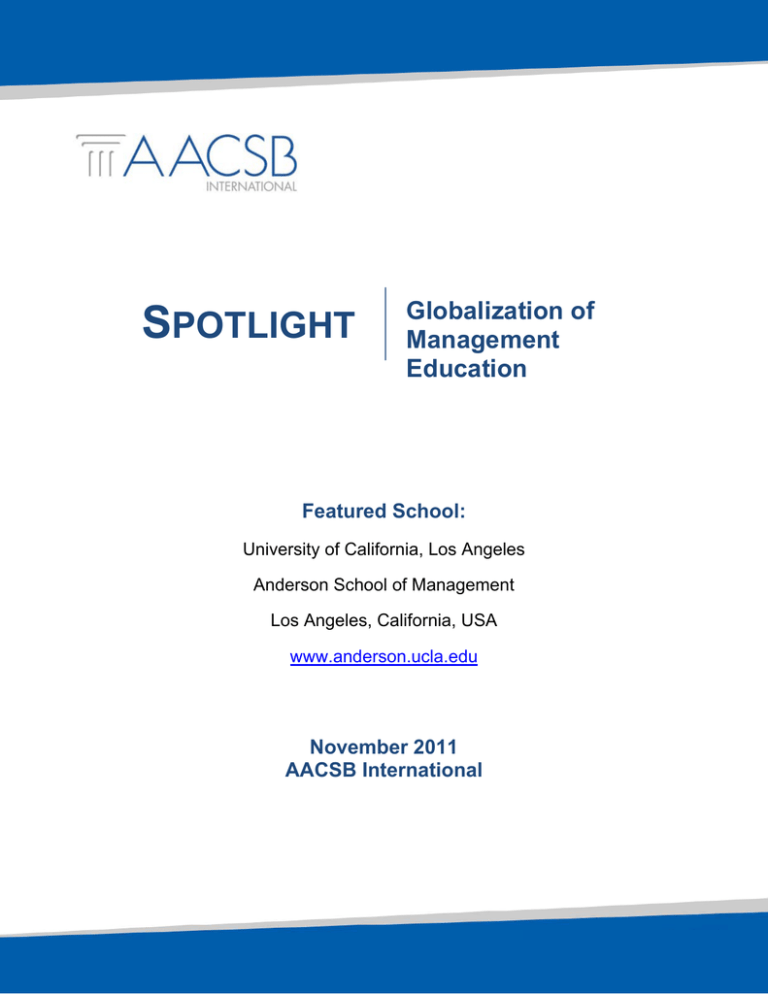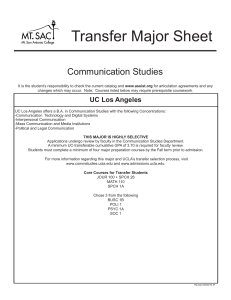
SPOTLIGHT
Globalization of
Management
Education
Featured School:
University of California, Los Angeles
Anderson School of Management
Los Angeles, California, USA
www.anderson.ucla.edu
November 2011
AACSB International
SPOTLIGHT | Globalization of Management Education
UCLA Anderson School of Management | 2
UCLA Anderson School of Management
The Anderson School of Management at the University of California, Los Angeles (UCLA) has longrecognized the importance of incorporating a global focus within its curriculum, programs, and school
culture. UCLA Anderson maintains this focus in its mission and continuously looks for ways to enhance its
global activities. The School’s dean, Judy D. Olian, has realized the importance of bringing focus to the
large range of global activities and initiatives: “We can’t be all things to all people,” says Olian, “and
cannot offer programs in all parts of the world.” With this in mind, UCLA Anderson implemented a “Global
Strategy,” which addresses the products and programs that called for further development in targeted
regions of the world. Although regions such as Europe and Australia have not been eliminated from the
School's global activities, UCLA Anderson's emphasis is placed on Asia and Latin America, mainly due to
the School's proximity to these regions as well as their opportunities for economic growth.
Global Strategy
UCLA Anderson's Global Strategy helps focus the various activities of the school, and enables it to
leverage its strengths, including “a strong reputation and globally known UCLA brand, the presence of
Anderson alumni everywhere, a world-class research faculty, outstanding degree programs with existing
global content, and the Dean’s global leadership roles.”1 The three primary objectives of UCLA
Anderson's Global Strategy are:
1. To enhance global learning opportunities and the School’s thought leadership
2. To enhance the global visibility of the School’s brand
3. To expand the independent sources of revenue for Anderson provided these opportunities satisfy
the first two objectives.2
The School's programs and activities have evolved to address the objectives of the Global Strategy. For
example, the school now has two global dual degree EMBA programs, greatly expanded global
immersion opportunities for students across all MBA degree programs, and over 15 programs that have
been completed over the last few years as part of the International Studies Courses concentrated mainly
in Asia and Latin America, but also elsewhere. A globalization requirement has been incorporated into
the School’s full-time MBA curriculum and a new Certificate in Global Management has recently been
introduced. The School has also established a Center for Global Management that serves as an umbrella
organization for global activity at UCLA Anderson. In addition, the school has expanded and developed
various global non-degree programs in fulfillment of UCLA’s public mission of improving community
capacity around the world.
© AACSB International. All Rights Reserved.
SPOTLIGHT | Globalization of Management Education
UCLA Anderson School of Management | 3
Global Brains
Regardless of the programs in which students participate, a key objective is for students to emerge with
“global brains,” or “an intuitive bias toward examining management, operational, and policy issues from
every angle.”3 Olian expands on this definition by describing three main characteristics of a student with
a “global brain”:
1. The ability to intuitively think of business opportunities and competitive pressures on a global
platform as opposed to within one’s immediate environment; an intuitive grasp of the global
market.
2. Cultural humility – not assuming that “my way is the best way” and being sensitive to
differences; recognizing that humility in the face of differences can reveal the strengths of
others.
3. Beyond awareness of global forces, understanding how they work. This entails a level of
analytical depth covering topics such as regulatory practices in different countries, currency
and exchange issues, global supply chain issues, the human resources complexities in global
corporations, differences in accounting models and systems, etc.
Faculty play an important role in shaping the “global brains” of students, and Olian stresses the
importance of bringing in faculty with a global mindset and with international experience, while also
finding ways of continuously expanding and encouraging their global exposure and development, whether
by actively engaging them in global degree and non-degree programs, or having them lead international
immersion programs.
The student community at UCLA Anderson is, according to Olian, “a critical part of global education.”
International students comprise 30-35 percent of the typical Anderson classroom. This diversity is
supplemented by the incorporation of global perspectives into students’ coursework and assignments, as
well as by extracurricular activities, including student-run signature conferences with a global focus such
as the annual Wilbur K. Woo Greater China Business Conference. Students in the full-time MBA program
are also required to fulfill at least one of three global requirements to graduate: an International Travel
Study course, an international Applied Management Research (AMR) field study project, or an
international exchange program.4 The AMR is a 20-week experiential learning project that full-time MBA
students can take in their second year, exposing student teams to corporate clients on a current business
problem, under the leadership of a faculty member.5 Each student works approximately 10 hours per
week examining a specific company, industry, and strategic opportunity. At the conclusion of the
program, teams develop a written and oral strategic implementation recommendation. Participating
organizations pay a 10,000 USD partnership fee plus payment of the team’s out-of-pocket expenses.6
© AACSB International. All Rights Reserved.
SPOTLIGHT | Globalization of Management Education
UCLA Anderson School of Management | 4
Challenging Students through Global Activities
The breadth of global programs and activities is extensive and diverse, but fits generally into one of three
categories:
1. Global Executive MBA (EMBA) Partnerships – These include the UCLA-National University of
Singapore (NUS) Global Executive MBA dual degree program, for which classes are conducted
in Los Angeles, Singapore, Shanghai, and Bangalore during six two-week segments over a
fifteen month period. Another is the UCLA-Universidad Adolfo Ibáñez (UAI) Global Executive
MBA for the Americas, with courses in Miami, Los Angeles, São Paulo, and Santiago.
2. Global immersion opportunities – This category encompasses a variety of activities. In
addition to the International Travel Study courses mentioned above, a key immersion opportunity
is the Global Access Program (GAP), which is the international field study and master’s thesis
requirement for UCLA Anderson's Fully Employed MBA (FEMBA) students. Students perform
extensive primary and secondary research and work closely with company executives to develop
a comprehensive business strategy that enables the companies to move to the next stage of their
corporate development.7 Since its inception, 2,250 MBA candidates have conducted research in
17 countries for 431 companies. Full-time MBA students have also engaged in global field study
projects focusing on microfinance, global child nutrition and healthcare in emerging markets such
as Belize, China, Guatemala, Honduras, India, Kenya, Paraguay, the Philippines, Samoa, and
Vietnam.
3. Global outreach as part of the School’s public mission – One example of a related activity is
the UCLA/Johnson & Johnson Management Development Institute (MDI) for HIV/AIDS, which is a
one-week program delivered in Ghana, Kenya, and South Africa. The program is designed to
enhance the management skills of program managers and leaders in African organizations
devoted to the care and treatment of the disease.8
To ensure that students are engaging in an authentic learning experience, all potential programs and
partners are carefully screened and, once implemented, regularly evaluated on their methods of
teaching, curricula, and student feedback. The first step – partnership selection – is seen as critical
to ensuring the quality of these programs. Evaluations of partnerships are carried out before and
after the onset of the program. UCLA Anderson has used this process to narrow its global
partnerships and now engages with fewer partners than in the past; though with some more
intensively. The goal is to offer students only the most intellectually challenging learning
opportunities.
© AACSB International. All Rights Reserved.
SPOTLIGHT | Globalization of Management Education
UCLA Anderson School of Management | 5
Enhancing Global Visibility
Maintaining a respected and highly recognized global brand is important for promoting and carrying
out UCLA Anderson’s mission. Visibility is enhanced in three ways, says Olian: through each of the
global programs; through the leadership of the faculty and dean; and through alumni, many of whom
are prominent and successful global business leaders and UCLA Anderson’s “best ambassadors.”
Olian also makes a point to attend conferences around the globe and to be responsive to media. She
spends a large amount of her time connecting with partners, programs, business leaders, and global
alumni chapters.
As time-consuming as these activities may be, they are a necessity. As Olian reminds her faculty and
staff repeatedly, “every school of business must be global since business is global. Our obligation is
to prepare students for careers that will last 20 to 40 years, and these careers will – without a doubt –
have a global flavor.”
Acknowledgements: AACSB International is grateful for the assistance of Judy D. Olian, Dean and John
E. Anderson Chair in Management at UCLA Anderson School of Management.
© AACSB International. All Rights Reserved.
SPOTLIGHT | Globalization of Management Education
UCLA Anderson School of Management | 6
End Notes 1
UCLA Anderson School of Management (2011). UCLA Anderson Global Strategy web page, http://www.anderson.ucla.edu/x20608.xml 2
UCLA Anderson School of Management (2011). UCLA Anderson Global Strategy web page, http://www.anderson.ucla.edu/x20608.xml 3
UCLA Anderson School of Management (2011). UCLA Anderson Global Strategy web page, http://www.anderson.ucla.edu/x20608.xml 4
UCLA Anderson School of Management (2011), A Tradition of Global Activities at UCLA Anderson web page, http://www.anderson.ucla.edu/Documents/areas/prg/gblc/GlobalFocus_FactSheet09.pdf 5
UCLA Anderson School of Management (2011). Academics web page, http://www.anderson.ucla.edu/x28616.xml 6
UCLA Anderson School of Management (2011). Applied Management Research Program web page, http://www.anderson.ucla.edu/x911.xml 7
UCLA Anderson School of Management (2011). Global Access Program web page, http://www.anderson.ucla.edu/x1294.xml 8
UCLA Anderson School of Management (2011), Programs web page, http://www.anderson.ucla.edu/x26690.xml#sigevents © AACSB International. All Rights Reserved.



